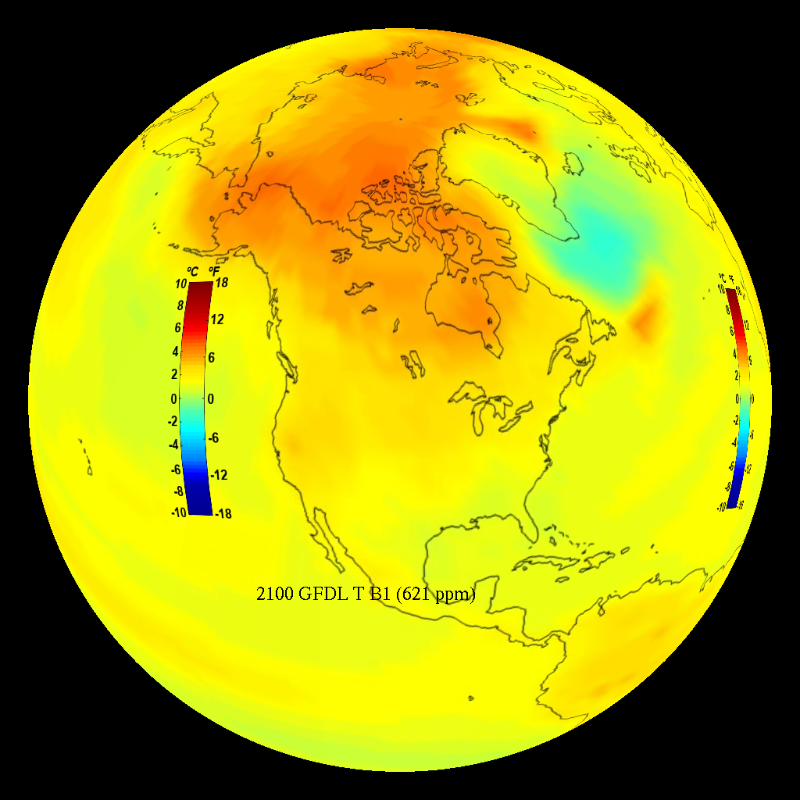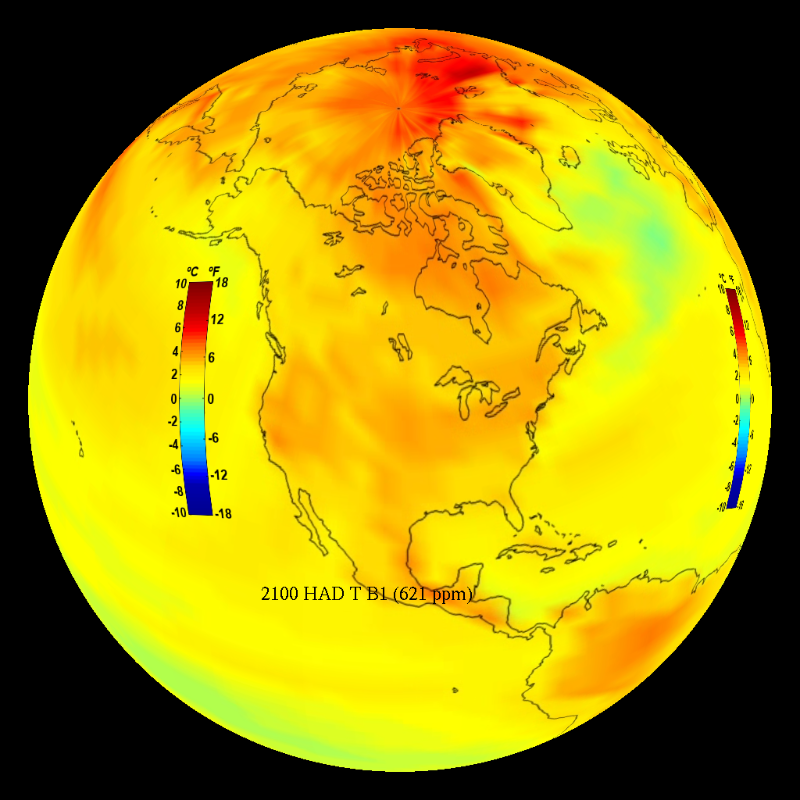Intergovernmental Panel on Climate Change - Temperature Change from 1870-2100
Description:
"The Intergovernmental Panel on Climate Change (IPCC) was established by WMO and UNEP to assess scientific, technical and socio- economic information relevant for the understanding of climate change, its potential impacts and options for adaptation and mitigation. It is open to all members of the UN and of WMO." - from www.ipcc.ch In an effort to better visualize the future of climate change, the IPCC releases assessment reports on the current state of the atmosphere and what the future could hold. Models from various atmospheric and oceanic organizations are included in these reports in order to establish a broad understanding of the science. Data from three of the IPCC models following temperature change from 1870 - 2100 have been formatted for Science On a Sphere® .
The models available on SOS are the Climate Model 2.1, developed by the Geophysical Fluid Dynamics Laboratory; the Community Climate System Model 3.0, developed by the National Center for Atmospheric Research; and the Hadley Centre HadCM3, developed by the United Kingdom Meteorology Office. All three models have similar forcing agents. For the past data they use the 20th Century Model 20C3M, which takes into account the historical record of greenhouse gases, sulfate aerosol concentrations, volcanic aerosol optical depths, and historical solar irradiation. For the future, there are two variations. Each model is available using the Special Report on Emissions Scenarios, SRES, A1B scenario, which assumes:
- Rapid economic growth
- A global population that reaches 9 billion in 2050 and then gradually declines.
- The quick spread of new and efficient technologies.
- A convergent world - income and way of life converge between regions. Extensive social and cultural interactions worldwide.
- A balanced emphasis on all energy sources
In addition, each model is also available using the more ecologically friendly SRES B1 scenario, which assumes:
- Rapid economic growth as in A1, but with rapid changes towards a service and information economy.
- Population rising to 9 billion in 2050 and then declining as in A1.
- Reductions in material intensity and the introduction of clean and resource efficient technologies.
- An emphasis on global solutions to economic, social and environmental stability.
Even though the all the models use the same inputs, the results vary because each of the three models have differing dynamics and physics parameterizations. In all of the models for the A1B scenario, CO2 production increases until it reaches 717ppm in the year 2100. For the B1 scenario, CO2 production increases until it reaches 621 ppm in the year 2100. The temperatures displayed in the datasets are all a comparison to temperatures in 2000. Blue tones on the visualization represent temperatures cooler than those in 2000, while red tones represent temperatures warmer than those in 2000.
In addition to the six model runs, there is a also a dataset has frames from the A1B and B1 scenario as modeled by GFDL for 2025, 2050, 2075, and 2100 in order to compare and contrast the differences between the two scenarios.
Notable Features:
| Model and Scenario |
Global Mean Warming |
North America Mean Warming |
| GFDL B1 |
2.7F (1.5C) |
4.32F (2.4C) |
| GFDL A1B |
5.22F (2.9C) |
8.82F (4.9C) |
| CCSM B1 |
2.52F (1.4C) |
3.24F (1.8C) |
| CCSM A1B |
4.86F (2.7C) |
7.56F (4.2C) |
| HAD B1 |
3.42F (1.9C) |
5.4F (3.0C) |
| HAD A1B |
6.66F (3.7C) |
10.26F (5.7C) |
Note: Global Mean Warming and North America Mean Warming are the difference between
decadal averages for 1990-2000 and 2090-2100. |
Data Category
Models and Simulations
Minor: IPCC
Keywords:
Models and Simulations, CO2, global warming, temperature, GFDL, NCAR, UKMET
| Data Set Name |
GFDL b1 Temp Change 1870-2100 |
| Data Set Directory Name |
ipcc_temp/gfdl b1 |
| Data Set Source |
Geophysical Fluid Dynamics Laboratory |
| Data Set Developer |
Geophysical Fluid Dynamics Laboratory |
| Visualization Developer |
Nikki Prive, NOAA/GSD |
| Audio |
No |
| Download |
FTP |
| Data Set Name |
GFDL a1b Temp Change 1870-2100 |
| Data Set Directory Name |
ipcc_temp/gfdl a1b |
| Data Set Source |
Geophysical Fluid Dynamics Laboratory |
| Data Set Developer |
Geophysical Fluid Dynamics Laboratory |
| Visualization Developer |
Nikki Prive, NOAA/GSD |
| Audio |
No |
| Download |
FTP |
| Google Earth |
KML file |
| Data Set Name |
IPCC GFDL Temp Comparison A1B and B1 |
| Data Set Directory Name |
ipcc_temp/compare |
| Data Set Source |
Geophysical Fluid Dynamics Laboratory |
| Data Set Developer |
Geophysical Fluid Dynamics Laboratory |
| Visualization Developer |
Nikki Prive, NOAA/GSD |
| Audio |
No |
| Download |
FTP |
| Data Set Name |
CCSM b1 Temp Change 1870-2100 |
| Data Set Directory Name |
ipcc_temp/ccsm b1 |
| Data Set Source |
National Center for Atmospheric Research |
| Data Set Developer |
National Center for Atmospheric Research |
| Visualization Developer |
Nikki Prive, NOAA/GSD |
| Audio |
No |
| Download |
FTP |
| Data Set Name |
CCSM a1b Temp Change 1870-2100 |
| Data Set Directory Name |
ipcc_temp/ccsm a1b |
| Data Set Source |
National Center for Atmospheric Research |
| Data Set Developer |
National Center for Atmospheric Research |
| Visualization Developer |
Nikki Prive, NOAA/GSD |
| Audio |
No |
| Download |
FTP |
| Data Set Name |
Hadley b1 Temp Change 1870-2100 |
| Data Set Directory Name |
ipcc_temp/had b1 |
| Data Set Source |
United Kingdom Meteorology Office |
| Data Set Developer |
United Kingdom Meteorology Office |
| Visualization Developer |
Nikki Prive, NOAA/GSD |
| Audio |
No |
| Download |
FTP |
| Data Set Name |
Hadley a1b Temp Change 1870-2100 |
| Data Set Directory Name |
ipcc_temp/had a1b |
| Data Set Source |
United Kingdom Meteorology Office |
| Data Set Developer |
United Kingdom Meteorology Office |
| Visualization Developer |
Nikki Prive, NOAA/GSD |
| Audio |
No |
| Download |
FTP |
| Google Earth |
KML file |


 GFDL a1b Temp Change 1870-2100 (6 mb)
GFDL a1b Temp Change 1870-2100 (6 mb) GFDL b1 Temp Change 1870-2100 (6 mb)
GFDL b1 Temp Change 1870-2100 (6 mb) Hadley a1b Temp Change 1870-2100 (6 mb)
Hadley a1b Temp Change 1870-2100 (6 mb) Hadley b1 Temp Change 1870-2100 (6 mb)
Hadley b1 Temp Change 1870-2100 (6 mb) CCSM b1 Temp Change 1870-2100 (6 mb)
CCSM b1 Temp Change 1870-2100 (6 mb) CCSM a1b Temp Change 1870-2100 (6 mb)
CCSM a1b Temp Change 1870-2100 (6 mb)